 | ÐлекÑÑоннÑй компоненÑ: FB2031BB | СкаÑаÑÑ:  PDF PDF  ZIP ZIP |
Äîêóìåíòàöèÿ è îïèñàíèÿ www.docs.chipfind.ru

Philips
Semiconductors
FB2031
9-bit latched/registered/pass-thru
Futurebus+ transceiver
Product specification
IC19 Data Handbook
1995 May 25
INTEGRATED CIRCUITS
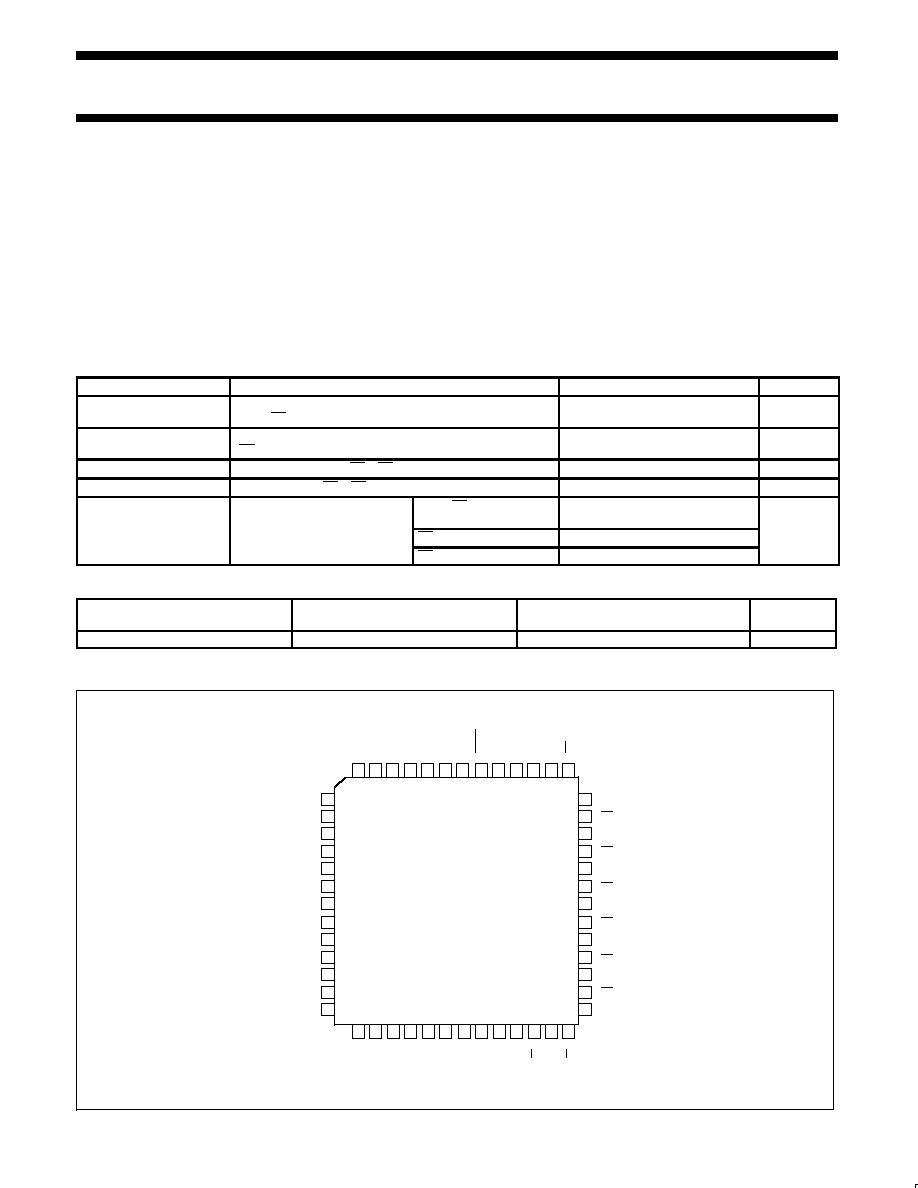
Philips Semiconductors
Product specification
FB2031
9-bit latched/registered/pass-thru Futurebus+ transceiver
2
1995 May 25
853-1714 15279
FEATURES
·
Latched, registered or straight through in
either A to B or B to A path
·
Drives heavily loaded backplanes with
equivalent load impedances down to 10
.
·
High drive 100mA BTL open collector
drivers on B-port
·
Allows incident wave switching in heavily
loaded backplane buses
·
Reduced BTL voltage swing produces less
noise and reduces power consumption
·
Built-in precision band-gap reference
provides accurate receiver thresholds and
improved noise immunity
·
Compatible with IEEE Futurebus+ or
proprietary BTL backplanes
·
Each BTL driver has a dedicated Bus GND
for a signal return
·
Controlled output ramp and multiple GND
pins minimize ground bounce
·
Glitch-free power up/power down operation
·
Low I
CC
current
·
Tight output skew
·
Supports live insertion
QUICK REFERENCE DATA
SYMBOL
PARAMETER
TYPICAL
UNIT
t
PLH
t
PHL
Propagation delay
An to Bn
2.7
ns
t
PLH
t
PHL
Propagation delay
Bn to An
4.4
4.2
ns
C
O
Output capacitance (B0 Bn only)
6
pF
I
OL
Output current (B0 Bn only)
100
mA
I
S
l
t
AIn to Bn
(outputs Low or High)
17
mA
I
CC
Supply current
Bn to AOn (outputs Low)
50
mA
Bn to AOn (outputs High)
25
ORDERING INFORMATION
PACKAGE
COMMERCIAL RANGE
V
CC
= 5V
±
10%; T
amb
= 0
°
C to +70
°
C
INDUSTRIAL RANGE
V
CC
= 5V
±
10%; T
amb
= 40
°
C to +85
°
C
DRAWING
NUMBER
52-pin Plastic Quad Flat Pack (QFP)
FB2031BB
CD3206BB
SOT379-1
PIN CONFIGURATION
52 51 50 49 48 47 46
45 44 43 42 41 40
39
38
37
36
35
34
33
32
31
30
29
28
27
1
2
3
4
5
6
7
8
9
10
11
12
13
14 15
16 17 18 19
20 21
22 23 24 25 26
BUS GND
B1
BUS GND
B2
BUS GND
B3
BUS GND
B4
BUS GND
B5
BUS GND
B6
BUS GND
LOGIC GND
A2
A3
A4
LOGIC GND
A5
A6
A7
LOGIC GND
BG GND
B7
BG V
CC
A1
A0
OEA
BIAS V
B0
V
CC
V
CC
9-Bit latched/registered transceiver
FB2031
52-lead PQFP
LOGIC GND
BUS GND
SEL0
OEB0
B8
A8
OEB1
TCK (option)
TMS (option)
BUS GND
V
CC
TDO (option)
TDI (option)
SEL1
LCBA
LCAB
LOGIC GND
LOGIC GND
LOGIC GND
LOGIC GND
SG00060

Philips Semiconductors
Product specification
FB2031
9-bit latched/registered/pass-thru Futurebus+ transceiver
1995 May 25
3
DESCRIPTION
The FB2031 is a 9-bit latched/registered
transceiver featuring a latched, registered or
pass-thru mode in either the A-to-B or B-to-A
direction. The FB2031 is intended to provide
the electrical interface to a high performance
wired-OR bus.
The TTL-level side (A port) has a common
I/O. The common I/O, open collector B port
operates at BTL signal levels. The logic
element for data flow in each direction is
controlled by two mode select inputs (SEL0
and SEL1). A "00" configures latches in both
directions. A "10" configures thru mode in
both directions. A "01" configures register
mode in both directions. A "11" configures
register mode in the A-to-B direction and
latch mode in the B-to-A direction.
When configured in the buffer mode, the
inverse of the input data appears at the
output port. In the register mode, data is
stored on the rising edge of the appropriate
clock input (LCAB or LCBA). In the latch
mode, clock pins serve as transparent-Low
latch enables. Regardless of the mode, data
is inverted from input to output.
The 3-State A port is enabled by asserting a
High level on OEA. The B port has two output
enables, OEB0 and OEB1. Only when OEB0
is High and OEB1 is Low is the output
enabled.
When either OEB0 is Low or OEB1 is High,
the B port is inactive and is pulled to the level
of the pullup voltage. New data can be
entered in the register and latched modes or
can be retained while the associated outputs
are in 3-State (A port) or inactive (B port).
The B-port drivers are Low-capacitance open
collectors with controlled ramp and are
designed to sink 100mA. Precision band gap
references on the B-port insure very good
noise margins by limiting the switching
threshold to a narrow region centered at
1.55V.
The B-port interfaces to "Backplane
Transceiver Logic" (see the IEEE 1194.1 BTL
standard). BTL features low power
consumption by reducing voltage swing (1V
p-p, between 1V and 2V) and reduced
capacitive loading by placing an internal
series diode on the drivers. BTL also
provides incident wave switching, a necessity
for high performance backplanes.
Output clamps are provided on the BTL
outputs to further reduce switching noise.
The "V
OH
" clamp reduces inductive ringing
effects during a Low-to-High transition. The
"V
OH
" clamp is always active. The other
clamp, the "trapped reflection" clamp, clamps
out ringing below the BTL 0.5V V
OL
level.
This clamp remains active for approximately
100ns after a High-to-Low transition.
To support live insertion, OEB0 is held Low
during power on/off cycles to insure glitch-
free B port drivers. Proper bias for B port
drivers during live insertion is provided by the
BIAS V pin when at a 5V level while V
CC
is
Low. The BIAS V pin is a low current input
which will reverse-bias the BTL driver series
Schottky diode, and also bias the B port
output pins to a voltage between 1.62V and
2.1V. This bias function is in accordance with
IEEE BTL Standard 1194.1. If live insertion is
not a requirement, the BIAS V pin should be
tied to a V
CC
pin.
The LOGIC GND and BUS GND pins are
isolated inside the package to minimize noise
coupling between the BTL and TTL sides.
These pins should be tied to a common
ground external to the package.
Each BTL driver has an associated BUS
GND pin that acts as a signal return path and
these BUS GND pins are internally isolated
from each other. In the event of a ground
return fault, a "hard" signal failure occurs
instead of a pattern dependent error that may
be infrequent and impossible to troubleshoot.
As with any high power device, thermal
considerations are critical. It is
recommended that airflow (300Ifpm)
and/or thermal mounting be used to
ensure proper junction temperature.
PACKAGE THERMAL CHARACTERISTICS
PARAMETER
CONDITION
52-PIN PLASTIC QFP
ja
Still air
80
°
C/W
ja
300 Linear feet per minute air flow
58
°
C/W
jc
Thermally mounted on one side to heat sink
20
°
C/W
PIN DESCRIPTION
SYMBOL
PIN NUMBER
TYPE
NAME AND FUNCTION
A0 A8
50, 52, 2, 4, 6, 8, 10, 12, 14
I/O
BiCMOS data inputs/3-State outputs (TTL)
B0 B8
40, 38, 36, 34, 32,
30, 28, 26, 24
I/O
Data inputs/Open Collector outputs, High current drive (BTL)
OEB0
46
Input
Enables the B outputs when High
OEB1
45
Input
Enables the B outputs when Low
OEA
47
Input
Enables the A outputs when High
BUS GND
25, 27, 29, 31, 33,
35, 37, 39, 41
GND
Bus ground (0V)
LOGIC GND
51, 1, 3, 5, 7, 9, 11, 13
GND
Logic ground (0V)
V
CC
23, 43, 49
Power
Positive supply voltage
BIAS V
48
Power
Live insertion pre-bias pin
BG V
CC
17
Power
Band Gap threshold voltage reference
BG GND
19
GND
Band Gap threshold voltage reference ground
SEL0
20
Input
Mode select
SEL1
15
Input
Mode select
LCAB
18
Input
A to B clock/latch enable (transparent latch when Low)
LCBA
16
Input
B to A clock/latch enable (transparent latch when Low)
TMS
42
Input
Test Mode Select (optional, if not implemented then no connect)
TCK
44
Input
Test Clock (optional, if not implemented then no connect)
TDI
22
Input
Test Data In (optional, if not implemented then no connect)
TDO
21
Output
Test Data Out (optional, if not implemented then shorted to TDI)
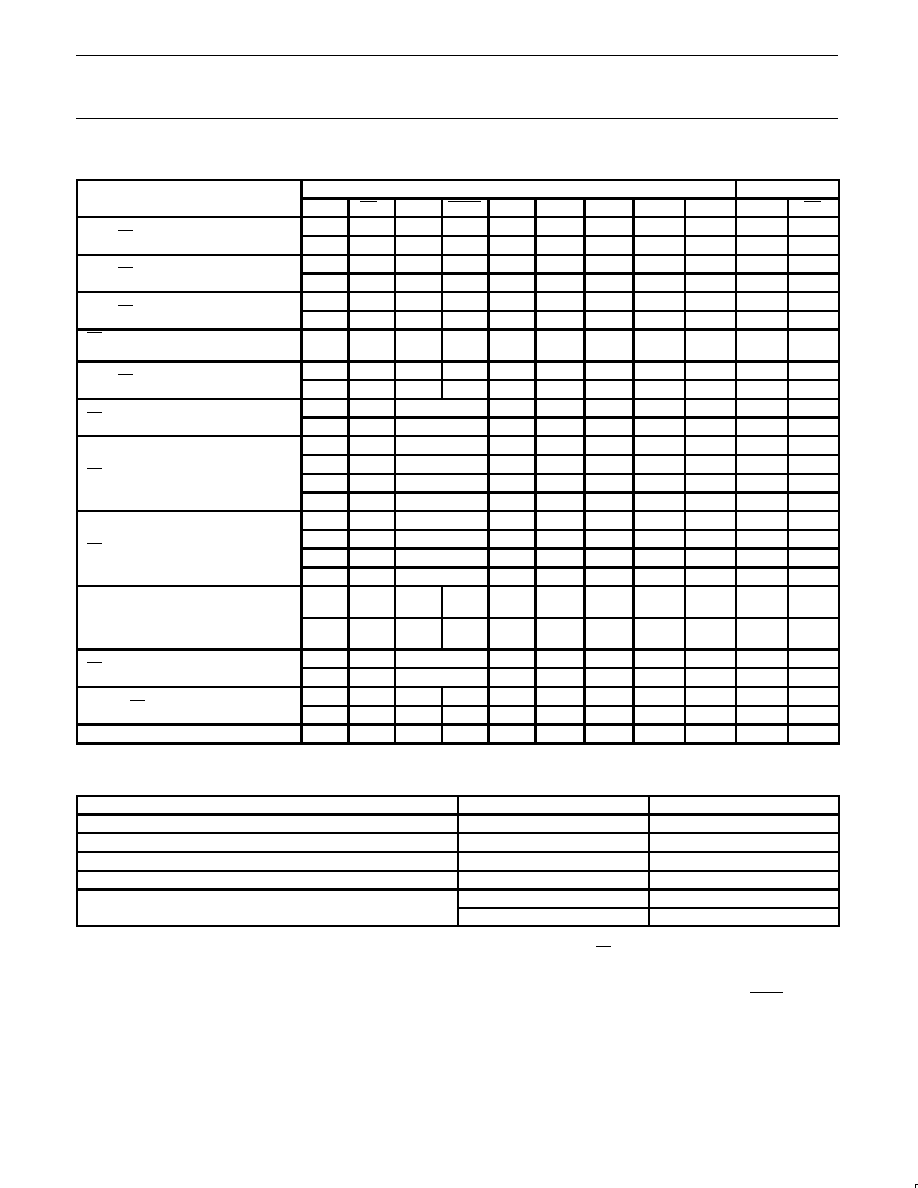
Philips Semiconductors
Product specification
FB2031
9-bit latched/registered/pass-thru Futurebus+ transceiver
1995 May 25
4
FUNCTION TABLE
MODE
INPUTS
OUTPUTS
MODE
An
Bn*
OEB0
OEB1
OEA
LCAB
LCBA
SEL0
SEL1
An
Bn
An to Bn thru mode
L
--
H
L
L
X
X
H
L
input
H**
An to Bn thru mode
H
--
H
L
L
X
X
H
L
input
L
An to Bn transparent latch
L
--
H
L
L
L
X
L
L
input
H**
An to Bn transparent latch
H
--
H
L
L
L
X
L
L
input
L
An to Bn latch and read
l
--
H
L
L
X
L
L
input
H**
An to Bn latch and read
h
--
H
L
L
X
L
L
input
L
Bn outputs latched and read
(preconditioned latch)
X
--
H
L
X
H
X
L
L
X
latched
data
An to Bn register
l
--
H
L
L
X
X
H
input
H**
An to Bn register
h
--
H
L
L
X
X
H
input
L
Bn to An thru mode
--
L
Disable
H
X
X
H
L
H
input
Bn to An thru mode
--
H
Disable
H
X
X
H
L
L
input
--
L
Disable
H
X
L
L
L
H
input
Bn to An transparent latch
--
H
Disable
H
X
L
L
L
L
input
Bn to An transparent latch
--
L
Disable
H
X
L
H
H
H
input
--
H
Disable
H
X
L
H
H
L
input
--
l
Disable
H
X
L
L
H
input
Bn to An latch and read
--
h
Disable
H
X
L
L
L
input
Bn to An latch and read
--
l
Disable
H
X
H
H
H
input
--
h
Disable
H
X
H
H
L
input
An outputs latched and read
--
X
X
X
H
X
H
L
L
latched
data
X
(preconditioned latch)
--
X
X
X
H
X
H
H
H
latched
data
X
Bn to An register
--
l
Disable
H
X
L
H
H
input
Bn to An register
--
h
Disable
H
X
L
H
L
input
Disable Bn outputs
X
X
L
X
X
X
X
X
X
X
H**
Disable Bn outputs
X
X
X
H
X
X
X
X
X
X
H**
Disable An outputs
X
X
X
X
L
X
X
X
X
Z
X
FUNCTION SELECT TABLE
MODE SELECTED
SEL0
SEL1
Thru mode
H
L
Register mode (An to Bn)
X
H
Latch mode (An to Bn)
L
L
Register mode (Bn to An)
L
H
Latch mode (Bn to An)
L
L
Latch mode (Bn to An)
H
H
NOTES:
H
=
High voltage level
L
=
Low voltage level
l
=
Low voltage level one set-up time
prior to the Low-to-High LCXX transition
h
=
High voltage level one set-up time
prior to the Low-to-High LCXX transition
X
=
Don't care
Z
=
High-impedance (OFF) state
--
=
Input not externally driven
=
Low-to-High transition
H** =
Goes to level of pull-up voltage
Bn* =
Precaution should be taken to
ensure B inputs do not float. If they do, they
are equal to Low state.
Disable = OEB0 is Low or OEB1 is High.
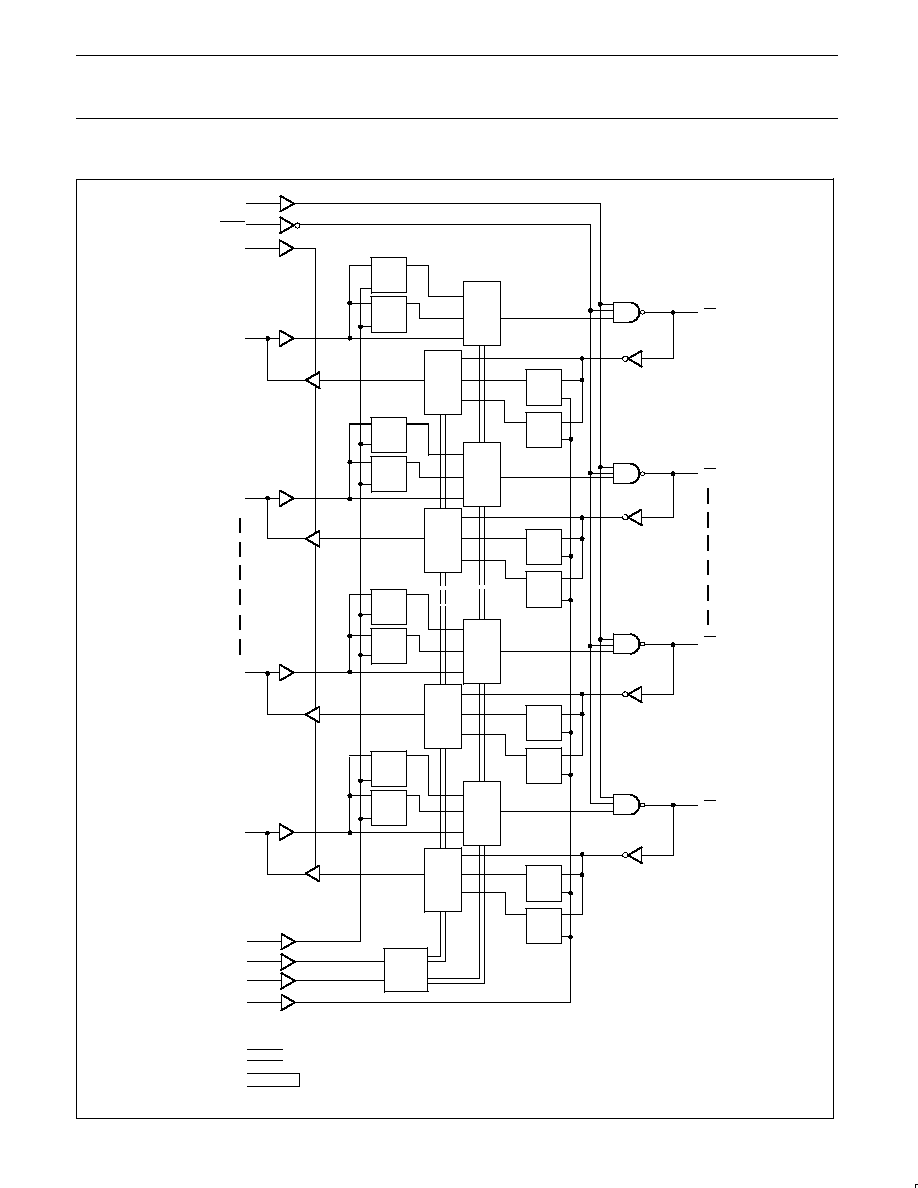
Philips Semiconductors
Product specification
FB2031
9-bit latched/registered/pass-thru Futurebus+ transceiver
1995 May 25
5
LOGIC DIAGRAM
Decode
Out
In
46
45
OEB0
OEB1
47
OEA
14
A8
D
Q
Clk
24
B8
38
18
LCAB
20
SEL0
28
30
32
34
36
BTL
TMS
TCK
TDI
TDO
42
44
22
21
(JTAG Boundary Scan pins)
LOGIC GND
=
1, 3, 5, 7, 9, 11, 13, 51
BUS GND
=
25, 27, 29, 31, 33, 35, 37, 39, 41
BIAS V
=
48
VCC
=
23, 43, 49
BG VCC
=
17
BG GND
=
19
D
Q
E
MUX
A
B
Q
D
MUX
A
B
26
B7
12
A7
MUX
A
B
52
10
8
6
4
2
TTL
A1
MUX
A
B
MUX
A
B
B1
40
50
MUX
A
B
MUX
A
B
B0
D
Q
Clk
D
Q
E
D
Q
Clk
D
Q
E
D
Q
Clk
D
Q
E
D
Q
Clk
D
Q
E
D
Q
E
D
Q
E
D
Q
Clk
D
Q
Clk
D
Q
E
15
SEL1
16
LCBA
D
Q
Clk
MUX
A
B
A0
SG00061
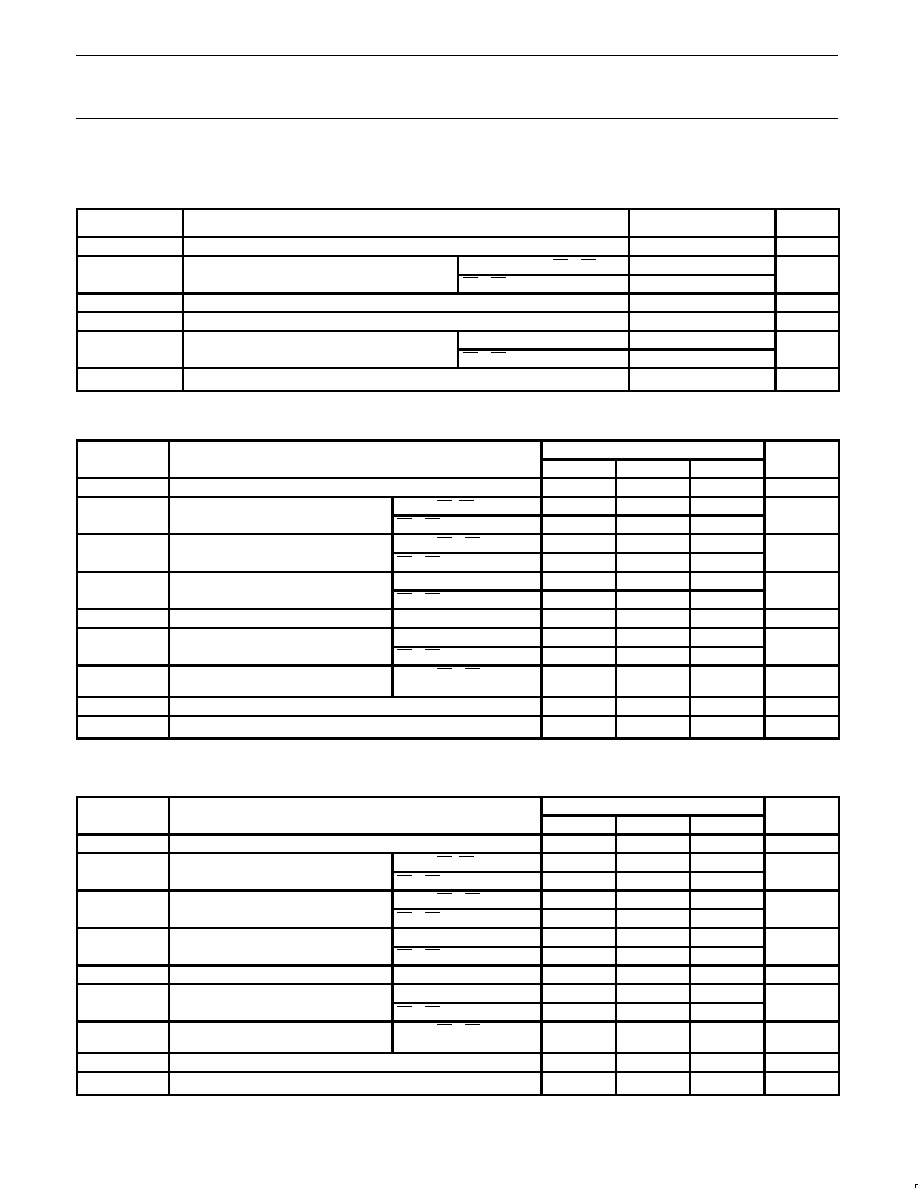
Philips Semiconductors
Product specification
FB2031
9-bit latched/registered/pass-thru Futurebus+ transceiver
1995 May 25
6
ABSOLUTE MAXIMUM RATINGS
Operation beyond the limits set forth in this table may impair the useful life of the device.
Unless otherwise noted these limits are over the operating free-air temperature range.
SYMBOL
PARAMETER
RATING
UNIT
V
CC
Supply voltage
-0.5 to +7.0
V
V
IN
Input voltage
All inputs except B0 B8
-1.2 to +7.0
V
B0 B8
-1.2 to +3.5
I
IN
Input current
-40 to +5.0
mA
V
OUT
Voltage applied to output in High output state
-0.5 to +V
CC
V
I
OUT
Current applied to output in Low output state
A0 A8
48
mA
B0 B8
200
T
STG
Storage temperature
-65 to +150
°
C
RECOMMENDED OPERATING CONDITIONS (Industrial)
SYMBOL
PARAMETER
LIMITS
UNIT
MIN
TYP
MAX
V
CC
Supply voltage
4.5
5.0
5.5
V
V
IH
High-level input voltage
Except B0B8
2.0
V
B0 B8
1.62
1.55
V
IL
Low-level input voltage
Except B0 B8
0.8
V
B0 B8
1.47
I
IK
Input clamp current
Control inputs
-40
mA
B0 B8 & A0 A8
-18
I
OH
High-level output current
A0 A8
-3
mA
I
OL
Low-level output current
A0 A8
24
mA
B0 B8
100
I
IA
Off device input current
Except B0 B8,
V
I
= 0 to 5.5V, V
CC
= 0V
100
µ
A
C
OB
Output capacitance of B port
6
7
pF
T
amb
Operating free-air temperature range
40
+85
°
C
RECOMMENDED OPERATING CONDITIONS (Commercial)
SYMBOL
PARAMETER
LIMITS
UNIT
MIN
TYP
MAX
V
CC
Supply voltage
4.5
5.0
5.5
V
V
IH
High-level input voltage
Except B0B8
2.0
V
B0 B8
1.62
1.55
V
IL
Low-level input voltage
Except B0 B8
0.8
V
B0 B8
1.47
I
IK
Input clamp current
Control inputs
-40
mA
B0 B8 & A0 A8
-18
I
OH
High-level output current
A0 A8
-3
mA
I
OL
Low-level output current
A0 A8
24
mA
B0 B8
100
I
IA
Off device input current
Except B0 B8,
V
I
= 0 to 5.5V, V
CC
= 0V
100
µ
A
C
OB
Output capacitance of B port
6
7
pF
T
amb
Operating free-air temperature range
0
+70
°
C

Philips Semiconductors
Product specification
FB2031
9-bit latched/registered/pass-thru Futurebus+ transceiver
1995 May 25
7
DC ELECTRICAL CHARACTERISTICS (Industrial)
Over recommended operating free-air temperature range unless otherwise noted.
SYMBOL
PARAMETER
TEST CONDITIONS
1
LIMITS
UNIT
MIN
TYP
2
MAX
I
OH
High level output current
B0 B8
V
CC
= MAX, V
IL
= MAX, V
IH
= MIN, V
OH
= 1.9V
100
µ
A
I
OFF
Power-off output current
B0 B8
V
CC
= 0.0V, V
IL
= MAX, V
IH
= MIN, V
OH
= 1.9V
200
µ
A
V
OH
High-level output voltage
A0 A8
4
V
CC
= MIN, V
IL
= MAX, V
IH
= MIN, I
OH
= -24mA
2.0
V
V
CC
= MIN, V
IL
= MAX, V
IH
= MIN, I
OH
= -3mA
2.5
2.85
A0 A8
4
V
CC
= MIN, V
IL
= MAX, V
IH
= MIN, I
OL
= 24mA
0.5
V
OL
Low-level output voltage
B0 B8
V
CC
= MIN, V
IL
= MAX, V
IH
= MIN, I
OL
= 80mA
.75
1.0
1.1
V
V
CC
= MIN, V
IL
= MAX, V
IH
= MIN, I
OL
= 100mA
1.15
V
CC
= MIN, V
IL
= MAX, V
IH
= MIN, I
OL
= 80mA
1.15
V
CC
= MIN, V
IL
= MAX, V
IH
= MIN, I
OL
= 4mA
0.5
V
IK
Input clamp voltage
Control pins
V
CC
= MIN, I
I
= I
IK
-0.5
A0 A8
B0 Bn
V
CC
= MIN, I
I
= -18mA
-1.2
V
I
I
Input current at maximum
input voltage
Except
B0B8
V
CC
= MAX, V
I
= 0.5V or 5.5V
±
50
µ
A
I
IH
High-level input current
Except
B0B8
V
CC
= MAX, V
I
= 2.7V
20
µ
A
B0 B8
V
CC
= MAX, V
I
= 1.9V
100
V
CC
= MAX, V
I
= 3.5V
5
100
mA
I
IL
Low-level input current
Except
B0B8
V
CC
= MAX, V
I
= 0.5V
-20
µ
A
B0 B8
V
CC
= MAX, V
I
= 0.75V
-100
I
IH
+ I
OZH
Off-state I/O High current
A0 A8
V
CC
= MAX, V
O
= 2.7V
50
µ
A
I
IL
+ I
OZL
Off-state I/O Low current
A0 A8
V
CC
= MAX, V
O
= 0.5V
-50
µ
A
I
OS
Short-circuit output
current
3
A0 A8
only
V
CC
= MAX, V
O
= 0.0V
-45
-150
mA
An to Bn
V
CC
= MAX, outputs Low or High
17
30
Bn to An
V
CC
= MAX, outputs Low
50
78
I
CC
Supply current (total)
Bn to An
V
CC
= MAX, outputs High
25
45
mA
I
CCZ
V
CC
= MAX, outputs 3-State
28
50
Worst case
V
CC
= MAX, all A and B outputs on
50
78
NOTES:
1. For conditions shown as MIN or MAX, use the appropriate value specified under recommended operation conditions for the applicable type.
2. All typical values are at V
CC
= 5V, T
amb
= 25
°
C.
3. Not more than one output should be shorted at a time. For testing I
OS
, the use of high-speed test apparatus and/or sample-and-hold
techniques are preferable in order to minimize internal heating and more accurately reflect operational values. Otherwise, prolonged shorting
of a High output may raise the chip temperature well above normal and thereby cause invalid readings in other parameter tests. In any
sequence of parameter tests, I
OS
tests should be performed last.
4. Due to test equipment limitations, actual test conditions are V
IH
= 1.8V and V
IL
= 1.3V for the B side.
5. For B port input voltage between 3 and 5 volts I
IH
will be greater than 100
µ
A, but the parts will continue to function normally.
6. B0 B8 clamps remain active for a minimum of 80ns following a High-to-Low transition.
7. Temperature range: 0 to +85
°
C.
8. Temperature range: 40 to 0
°
C.
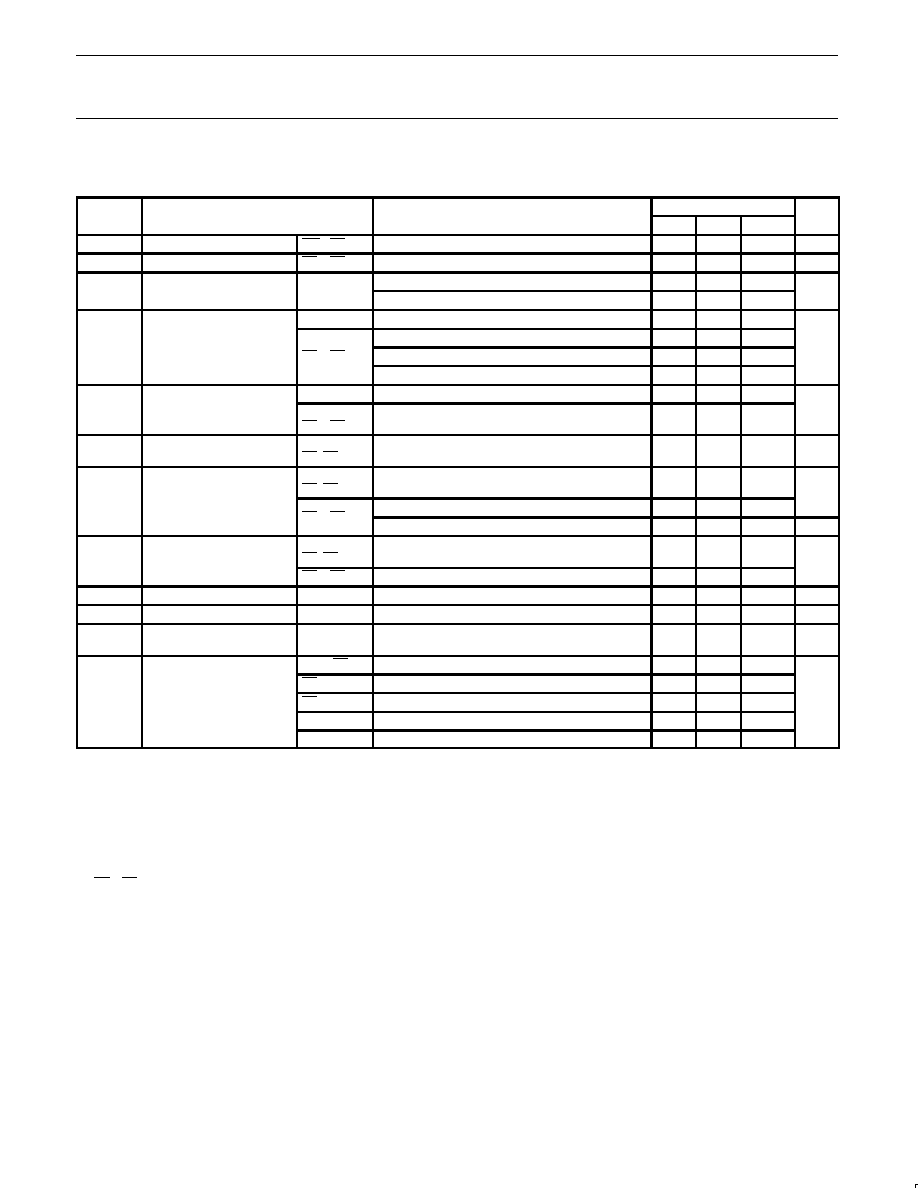
Philips Semiconductors
Product specification
FB2031
9-bit latched/registered/pass-thru Futurebus+ transceiver
1995 May 25
8
DC ELECTRICAL CHARACTERISTICS (Commercial)
Over recommended operating free-air temperature range unless otherwise noted.
SYMBOL
PARAMETER
TEST CONDITIONS
1
LIMITS
UNIT
SYMBOL
PARAMETER
TEST CONDITIONS
1
MIN
TYP
2
MAX
UNIT
I
OH
High level output current
B0 B8
V
CC
= MAX, V
IL
= MAX, V
IH
= MIN, V
OH
= 1.9V
100
µ
A
I
OFF
Power-off output current
B0 B8
V
CC
= 0.0V, V
IL
= MAX, V
IH
= MIN, V
OH
= 1.9V
100
µ
A
V
O
High level output voltage
A0
A8
4
V
CC
= MIN, V
IL
= MAX, V
IH
= MIN, I
OH
= -24mA
2.0
V
V
OH
High-level output voltage
A0 A8
4
V
CC
= MIN, V
IL
= MAX, V
IH
= MIN, I
OH
= -3mA
2.5
2.85
V
A0 A8
4
V
CC
= MIN, V
IL
= MAX, V
IH
= MIN, I
OL
= 24mA
0.5
V
O
Low level output voltage
V
CC
= MIN, V
IL
= MAX, V
IH
= MIN, I
OL
= 80mA
.75
1.0
1.1
V
V
OL
Low-level output voltage
B0 B8
V
CC
= MIN, V
IL
= MAX, V
IH
= MIN, I
OL
= 100mA
1.15
V
V
CC
= MIN, V
IL
= MAX, V
IH
= MIN, I
OL
= 4mA
0.5
Control pins
V
CC
= MIN, I
I
= I
IK
-0.5
V
IK
Input clamp voltage
A0 A8
B0 Bn
V
CC
= MIN, I
I
= -18mA
-1.2
V
I
I
Input current at maximum
input voltage
Except
B0B8
V
CC
= MAX, V
I
= 0.0V or 5.5V
±
50
µ
A
I
Hi h l
l i
t
t
Except
B0B8
V
CC
= MAX, V
I
= 2.7V
20
µ
A
I
IH
High-level input current
B0
B8
V
CC
= MAX, V
I
= 1.9V
100
µ
A
B0 B8
V
CC
= MAX, V
I
= 3.5V
5
100
mA
I
IL
Low-level input current
Except
B0B8
V
CC
= MAX, V
I
= 0.5V
-20
µ
A
IL
B0 B8
V
CC
= MAX, V
I
= 0.75V
-100
µ
I
IH
+ I
OZH
Off-state I/O High current
A0 A8
V
CC
= MAX, V
O
= 2.7V
50
µ
A
I
IL
+ I
OZL
Off-state I/O Low current
A0 A8
V
CC
= MAX, V
O
= 0.5V
-50
µ
A
I
OS
Short-circuit output
current
3
A0 A8
only
V
CC
= MAX, V
O
= 0.0V
-45
-150
mA
An to Bn
V
CC
= MAX, outputs Low or High
17
30
Bn to An
V
CC
= MAX, outputs Low
50
78
I
CC
Supply current (total)
Bn to An
V
CC
= MAX, outputs High
25
45
mA
I
CCZ
V
CC
= MAX, outputs 3-State
28
50
Worst case
V
CC
= MAX, all A and B outputs on
50
78
NOTES:
1. For conditions shown as MIN or MAX, use the appropriate value specified under recommended operation conditions for the applicable type.
2. All typical values are at V
CC
= 5V, T
amb
= 25
°
C.
3. Not more than one output should be shorted at a time. For testing I
OS
, the use of high-speed test apparatus and/or sample-and-hold
techniques are preferable in order to minimize internal heating and more accurately reflect operational values. Otherwise, prolonged shorting
of a High output may raise the chip temperature well above normal and thereby cause invalid readings in other parameter tests. In any
sequence of parameter tests, I
OS
tests should be performed last.
4. Due to test equipment limitations, actual test conditions are V
IH
= 1.8V and V
IL
= 1.3V for the B side.
5. For B port input voltage between 3 and 5 volts I
IH
will be greater than 100
µ
A, but the parts will continue to function normally.
6. B0 B8 clamps remain active for a minimum of 80ns following a High-to-Low transition.

Philips Semiconductors
Product specification
FB2031
9-bit latched/registered/pass-thru Futurebus+ transceiver
1995 May 25
9
LIVE INSERTION SPECIFICATIONS
SYMBOL
PARAMETER
LIMITS
UNIT
SYMBOL
PARAMETER
MIN
NOM
MAX
UNIT
V
BIASV
Bias pin voltage
V
CC
= 0 to 5.25V, Bn = 0 to 2.0V
4.5
5.5
V
I
BIASV
Bias pin DC current
V
CC
= 0 to 4.75V, Bn = 0 to 2.0V,
Bias V = 4.5 to 5.5V
1
mA
I
BIASV
Bias in DC current
V
CC
= 4.5 to 5.5V, Bn = 0 to 2.0V,
Bias V = 4.5 to 5.5V
10
µ
A
V
Bn
Bus voltage during prebias
B0 B8 = 0V, Bias V = 5.0V
1.62
2.1
V
I
LM
Fall current during prebias
B0 B8 = 2V, Bias V = 4.5 to 5.5V
1
µ
A
I
HM
Rise current during prebias
B0 B8 = 1V, Bias V = 4.5 to 5.5V
-1
µ
A
I
Bn
PEAK
Peak bus current during
insertion
V
CC
= 0 to 5.25V, B0 B8 = 0 to 2.0V,
Bias V = 4.5 to 5.5V, OEB0 = 0.8V, t
r
= 2ns
10
mA
I
OL
OFF
Power up current
V
CC
= 0 to 5.25V, OEB0 = 0.8V
100
µ
A
I
OL
OFF
Power u current
V
CC
= 0 to 2.2V, OEB0 = 0 to 5V
100
µ
A
t
GR
Input glitch rejection
V
CC
= 5.0V
1.35
1.0
ns
AC ELECTRICAL CHARACTERISTICS (Industrial)
A PORT LIMITS
SYMBOL
PARAMETER
TEST
CONDITION
T
amb
= +25
°
C, V
CC
= 5V,
C
L
= 50pF, R
L
= 500
T
amb
= 40 to +85
°
C,
V
CC
= 5V
±
10%,
C
L
= 50pF, R
L
= 500
UNIT
MIN
TYP
MAX
MIN
MAX
f
MAX
Maximum clock frequency
Waveform 4
120
150
100
MHz
t
PLH
t
PHL
Propagation delay (thru mode)
Bn to An
Waveform 1, 2
2.5
2.4
4.4
4.2
5.9
5.5
2.3
2.4
7.0
6.2
ns
t
PLH
t
PHL
Propagation delay (transparent latch)
Bn to An
Waveform 1, 2
2.9
2.8
4.6
4.3
6.2
5.9
2.7
2.5
7.1
7.0
ns
t
PLH
t
PHL
Propagation delay
LCBA to An
Waveform 1, 2
2.6
2.4
4.1
4.7
5.5
6.1
2.0
2.0
6.2
6.8
ns
t
PLH
t
PHL
Propagation delay
SEL0 or SEL1 to An
Waveform 1, 2
1.5
1.7
3.8
3.9
5.2
6.0
1.2
1.5
6.2
6.5
ns
t
PZH
t
PZL
Output enable time from High or Low
OEA to An
Waveform 5, 6
2.1
2.0
3.5
3.8
4.8
5.3
1.8
1.7
6.0
6.3
ns
t
PHZ
t
PLZ
Output disable time to High or Low
OEA to An
Waveform 5, 6
1.9
1.7
3.4
3.2
4.8
4.8
1.6
1.5
5.5
5.5
ns
t
TLH
t
THL
Output transition time, An Port
10% to 90%, 90% to 10%
Test Circuit and
Waveforms
3.0
1.7
7.5
4.0
ns
t
SK
(o)
Output to output skew for multiple
channels
1
Waveform 3
0.5
1.0
1.5
ns
t
SK
(p)
Pulse skew
2
t
PHL
t
PLH
MAX
Waveform 2
0.5
1.0
1.0
ns
NOTES:
1. For conditions shown as MIN or MAX, use the appropriate value specified under recommended operation conditions for the applicable type.
2. All typical values are at V
CC
= 5V, T
amb
= 25
°
C.
3. Not more than one output should be shorted at a time. For testing I
OS
, the use of high-speed test apparatus and/or sample-and-hold
techniques are preferable in order to minimize internal heating and more accurately reflect operational values. Otherwise, prolonged shorting
of a High output may raise the chip temperature well above normal and thereby cause invalid readings in other parameter tests. In any
sequence of parameter tests, I
OS
tests should be performed last.
4. Due to test equipment limitations, actual test conditions are V
IH
= 1.8V and V
IL
= 1.3V for the B side.
5. For B port input voltage between 3 and 5 volts I
IH
will be greater than 100
µ
A, but the parts will continue to function normally.
6. B0 B8 clamps remain active for a minimum of 80ns following a High-to-Low transition.
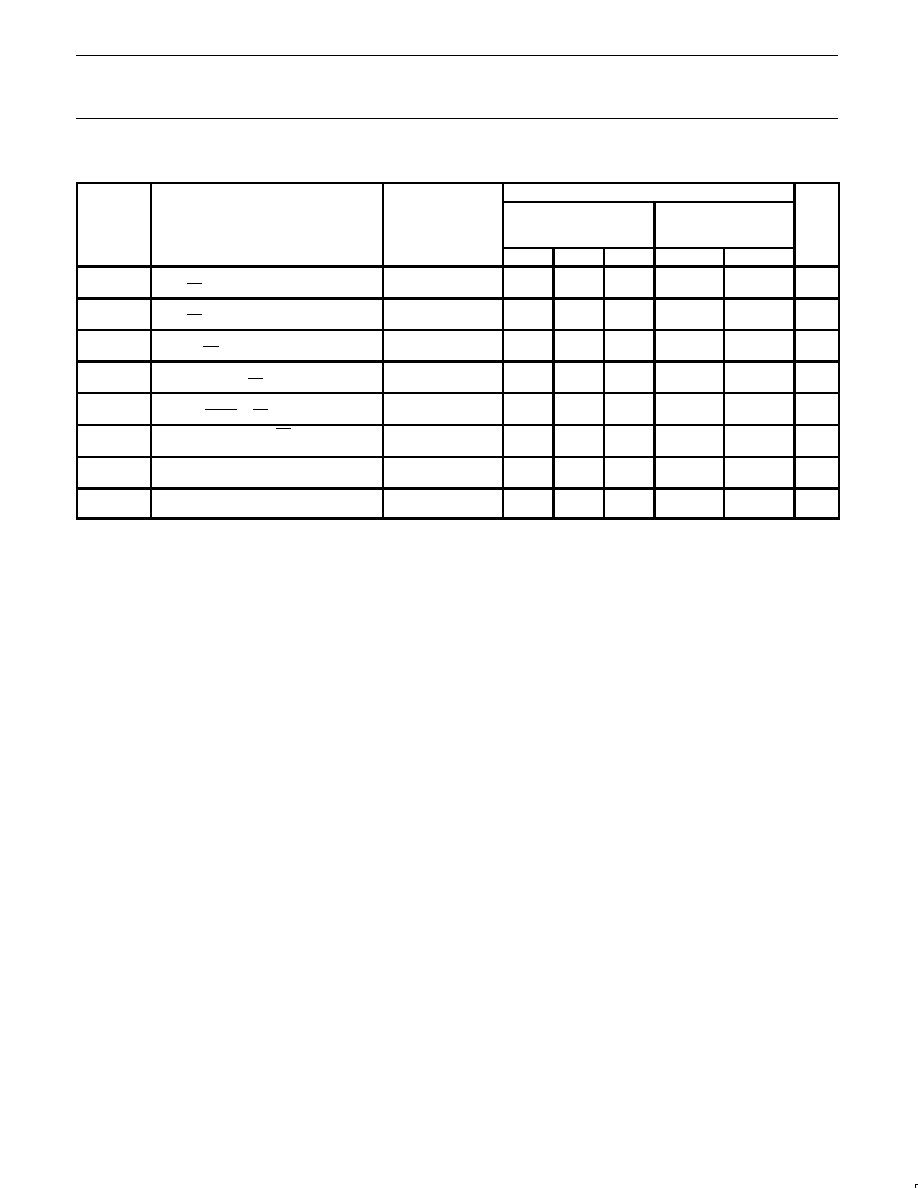
Philips Semiconductors
Product specification
FB2031
9-bit latched/registered/pass-thru Futurebus+ transceiver
1995 May 25
10
AC ELECTRICAL CHARACTERISTICS (Industrial)
B PORT LIMITS
SYMBOL
PARAMETER
TEST
CONDITION
T
amb
= +25
°
C, V
CC
= 5V,
C
D
= 30pF, R
U
= 16.5
T
amb
= 40 to +85
°
C,
V
CC
= 5V
±
10%,
C
D
= 30pF, R
U
= 16.5
UNIT
MIN
TYP
MAX
MIN
MAX
t
PLH
t
PHL
Propagation delay (thru mode)
An to Bn
Waveform 1, 2
1.0
1.0
3.0
2.7
5.0
4.0
1.5
1.5
5.7
4.5
ns
t
PLH
t
PHL
Propagation delay (transparent latch)
An to Bn
Waveform 1, 2
1.0
1.0
3.2
3.1
5.0
4.2
1.5
1.5
5.5
5.0
ns
t
PLH
t
PHL
Propagation delay
LCAB to Bn
Waveform 1, 2
2.0
1.5
4.0
4.0
5.5
5.5
1.5
1.5
6.5
6.0
ns
t
PLH
t
PHL
Propagation delay
SEL0 or SEL1 to Bn
Waveform 1, 2
2.0
1.5
3.5
2.3
5.5
4.5
2.0
1.0
6.1
5.5
ns
t
PZH
t
PZL
Enable/disable time
OEB0 or OEB1 to Bn
Waveform 1, 2
1.5
1.2
3.0
2.4
5.0
4.5
1.0
1.0
5.7
5.5
ns
t
TLH
t
THL
Output transition time, Bn Port
(1.3V to 1.8V)
Test Circuit and
Waveforms
1.0
0.6
2.0
3.0
0.9
0.6
3.0
3.0
ns
t
SK(o)
Output to output skew for multiple
channels
1
Waveform 3
1.0
0.4
1.6
1.6
ns
t
SK
(p)
Pulse skew
2
t
PHL
t
PLH
MAX
Waveform 2
0.3
1.0
1.5
ns
NOTES:
1.
t
PN
actual t
PM
actual
for any data input to output path compared to any other data input to output path where N and M are either LH or
HL. Skew times are valid only under same test conditions (temperature, V
CC
, loading, etc.).
2. t
SK
(p) is used to quantify duty cycle characteristics. In essence it compares the input signal duty cycle to the corresponding output signal
duty cycle (50MHz input frequency and 50% duty cycle, tested on data paths only).
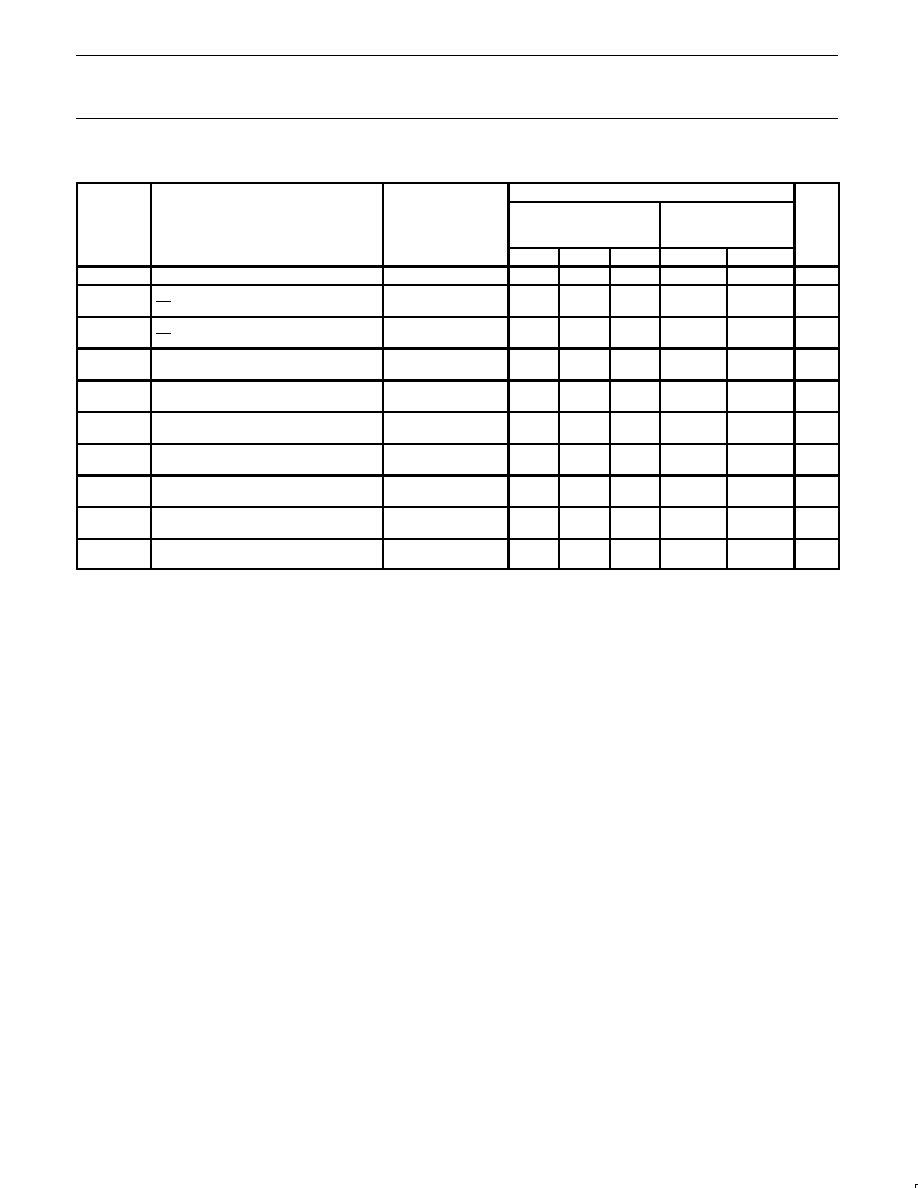
Philips Semiconductors
Product specification
FB2031
9-bit latched/registered/pass-thru Futurebus+ transceiver
1995 May 25
11
AC ELECTRICAL CHARACTERISTICS (Commercial)
A PORT LIMITS
SYMBOL
PARAMETER
TEST
CONDITION
T
amb
= +25
°
C, V
CC
= 5V,
C
L
= 50pF, R
L
= 500
T
amb
= 0 to +70
°
C,
V
CC
= 5V
±
10%,
C
L
= 50pF, R
L
= 500
UNIT
MIN
TYP
MAX
MIN
MAX
f
MAX
Maximum clock frequency
Waveform 4
120
150
100
MHz
t
PLH
t
PHL
Propagation delay (thru mode)
Bn to An
Waveform 1, 2
2.5
2.4
4.4
4.2
5.9
5.5
2.3
2.4
6.6
5.9
ns
t
PLH
t
PHL
Propagation delay (transparent latch)
Bn to An
Waveform 1, 2
2.9
2.8
4.6
4.3
6.2
5.9
2.7
2.5
7.0
6.5
ns
t
PLH
t
PHL
Propagation delay
LCBA to An
Waveform 1, 2
2.6
2.4
4.1
4.7
5.5
6.1
2.0
2.0
6.0
6.5
ns
t
PLH
t
PHL
Propagation delay
SEL0 or SEL1 to An
Waveform 1, 2
1.5
1.7
3.8
3.9
5.2
6.0
1.2
1.5
6.0
6.5
ns
t
PZH
t
PZL
Output enable time from High or Low
OEA to An
Waveform 5, 6
2.1
2.0
3.5
3.8
4.8
5.3
1.8
1.7
5.8
6.0
ns
t
PHZ
t
PLZ
Output disable time to High or Low
OEA to An
Waveform 5, 6
1.9
1.7
3.4
3.2
4.8
4.8
1.6
1.5
5.4
5.4
ns
t
TLH
t
THL
Output transition time, An Port
10% to 90%, 90% to 10%
Test Circuit and
Waveforms
2.0
1.0
7.5
3.5
ns
t
SK
(o)
Output to output skew for multiple
channels
1
Waveform 3
0.5
1.0
1.5
ns
t
SK
(p)
Pulse skew
2
t
PHL
t
PLH
MAX
Waveform 2
0.5
1.0
1.0
ns
NOTES:
1.
t
PN
actual t
PM
actual
for any data input to output path compared to any other data input to output path where N and M are either LH or HL.
Skew times are valid only under same test conditions (temperature, V
CC
, loading, etc.).
2. t
SK
(p) is used to quantify duty cycle characteristics. In essence it compares the input signal duty cycle to the corresponding output signal
duty cycle (50MHz input frequency and 50% duty cycle, tested on data paths only).
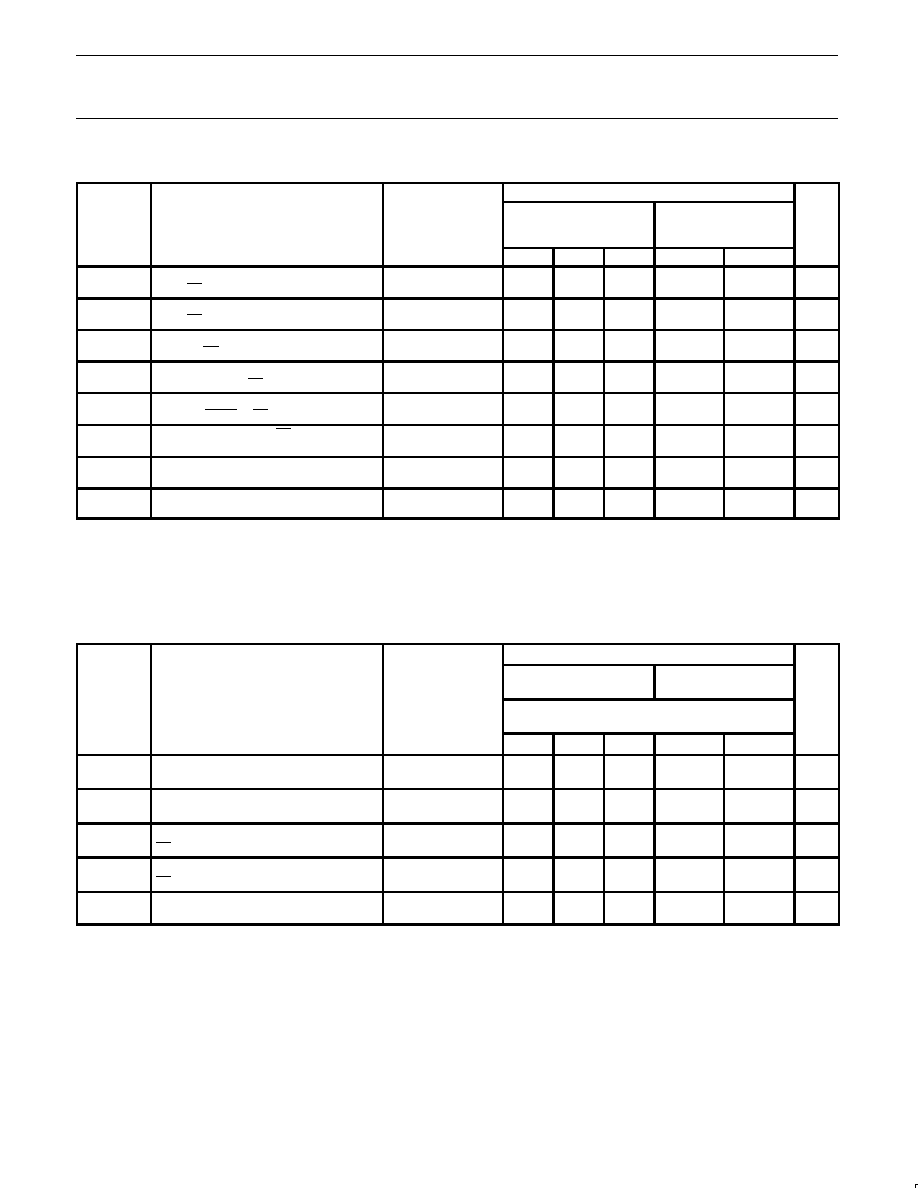
Philips Semiconductors
Product specification
FB2031
9-bit latched/registered/pass-thru Futurebus+ transceiver
1995 May 25
12
AC ELECTRICAL CHARACTERISTICS (Commercial)
B PORT LIMITS
SYMBOL
PARAMETER
TEST
CONDITION
T
amb
= +25
°
C, V
CC
= 5V,
C
D
= 30pF, R
U
= 16.5
T
amb
= 0 to +70
°
C,
V
CC
= 5V
±
10%,
C
D
= 30pF, R
U
= 16.5
UNIT
MIN
TYP
MAX
MIN
MAX
t
PLH
t
PHL
Propagation delay (thru mode)
An to Bn
Waveform 1, 2
1.0
1.0
3.0
2.7
5.0
4.0
1.0
0.5
5.5
4.5
ns
t
PLH
t
PHL
Propagation delay (transparent latch)
An to Bn
Waveform 1, 2
1.0
1.0
3.2
3.1
5.0
4.2
1.0
0.8
5.5
4.5
ns
t
PLH
t
PHL
Propagation delay
LCAB to Bn
Waveform 1, 2
2.0
1.5
4.0
4.0
5.5
5.5
1.5
1.0
6.0
6.0
ns
t
PLH
t
PHL
Propagation delay
SEL0 or SEL1 to Bn
Waveform 1, 2
2.0
1.5
3.5
2.3
5.5
4.5
2.0
1.0
6.0
5.0
ns
t
PZH
t
PZL
Enable/disable time
OEB0 or OEB1 to Bn
Waveform 1, 2
1.5
1.5
3.0
2.4
5.0
4.5
1.0
0.8
5.5
5.5
ns
t
TLH
t
THL
Output transition time, Bn Port
(1.3V to 1.8V)
Test Circuit and
Waveforms
1.0
0.6
2.0
3.0
1.0
0.6
2.3
2.3
ns
t
SK(o)
Output to output skew for multiple
channels
1
Waveform 3
0.4
1.0
1.6
ns
t
SK
(p)
Pulse skew
2
t
PHL
t
PLH
MAX
Waveform 2
0.3
1.0
1.5
ns
NOTES:
1.
t
PN
actual t
PM
actual
for any data input to output path compared to any other data input to output path where N and M are either LH or
HL. Skew times are valid only under same test conditions (temperature, V
CC
, loading, etc.).
2. t
SK
(p) is used to quantify duty cycle characteristics. In essence it compares the input signal duty cycle to the corresponding output signal
duty cycle (50MHz input frequency and 50% duty cycle, tested on data paths only).
AC SETUP REQUIREMENTS (Industrial)
LIMITS
SYMBOL
PARAMETER
TEST
CONDITION
T
amb
= +25
°
C, V
CC
= 5V,
T
amb
= 40 to +85
°
C,
V
CC
= 5V
±
10%,
UNIT
C
L
= 50pF (A side) / C
D
= 30pF (B side)
R
L
= 500
(A side) / R
U
= 16.5
(B side)
MIN
TYP
MAX
MIN
MAX
t
s
(H)
t
s
(L)
Setup time
An to LCAB
Waveform 4
1.0
1.0
1.5
1.0
ns
t
h
(H)
t
h
(L)
Hold time
An to LCAB
Waveform 4
1.0
1.0
2.0
1.0
ns
t
s
(H)
t
s
(L)
Setup time
Bn to LCBA
Waveform 4
2.0
2.0
3.0
3.0
ns
t
h
(H)
t
h
(L)
Hold time
Bn to LCBA
Waveform 4
0.0
0.0
0.0
0.0
ns
t
w
(H)
t
w
(L)
Pulse width, High or Low
LCAB or LCBA
Waveform 4
3.0
3.0
3.0
3.0
ns

Philips Semiconductors
Product specification
FB2031
9-bit latched/registered/pass-thru Futurebus+ transceiver
1995 May 25
13
AC SETUP REQUIREMENTS (Commercial)
LIMITS
SYMBOL
PARAMETER
TEST
CONDITION
T
amb
= +25
°
C, V
CC
= 5V,
T
amb
= 0 to +70
°
C,
V
CC
= 5V
±
10%,
UNIT
C
L
= 50pF (A side) / C
D
= 30pF (B side)
R
L
= 500
(A side) / R
U
= 16.5
(B side)
MIN
TYP
MAX
MIN
MAX
t
s
(H)
t
s
(L)
Setup time
An to LCAB
Waveform 4
1.0
1.0
1.5
1.0
ns
t
h
(H)
t
h
(L)
Hold time
An to LCAB
Waveform 4
1.0
1.0
2.0
1.0
ns
t
s
(H)
t
s
(L)
Setup time
Bn to LCBA
Waveform 4
2.0
2.0
3.0
3.0
ns
t
h
(H)
t
h
(L)
Hold time
Bn to LCBA
Waveform 4
0.0
0.0
0.0
0.0
ns
t
w
(H)
t
w
(L)
Pulse width, High or Low
LCAB or LCBA
Waveform 4
3.0
3.0
3.0
3.0
ns
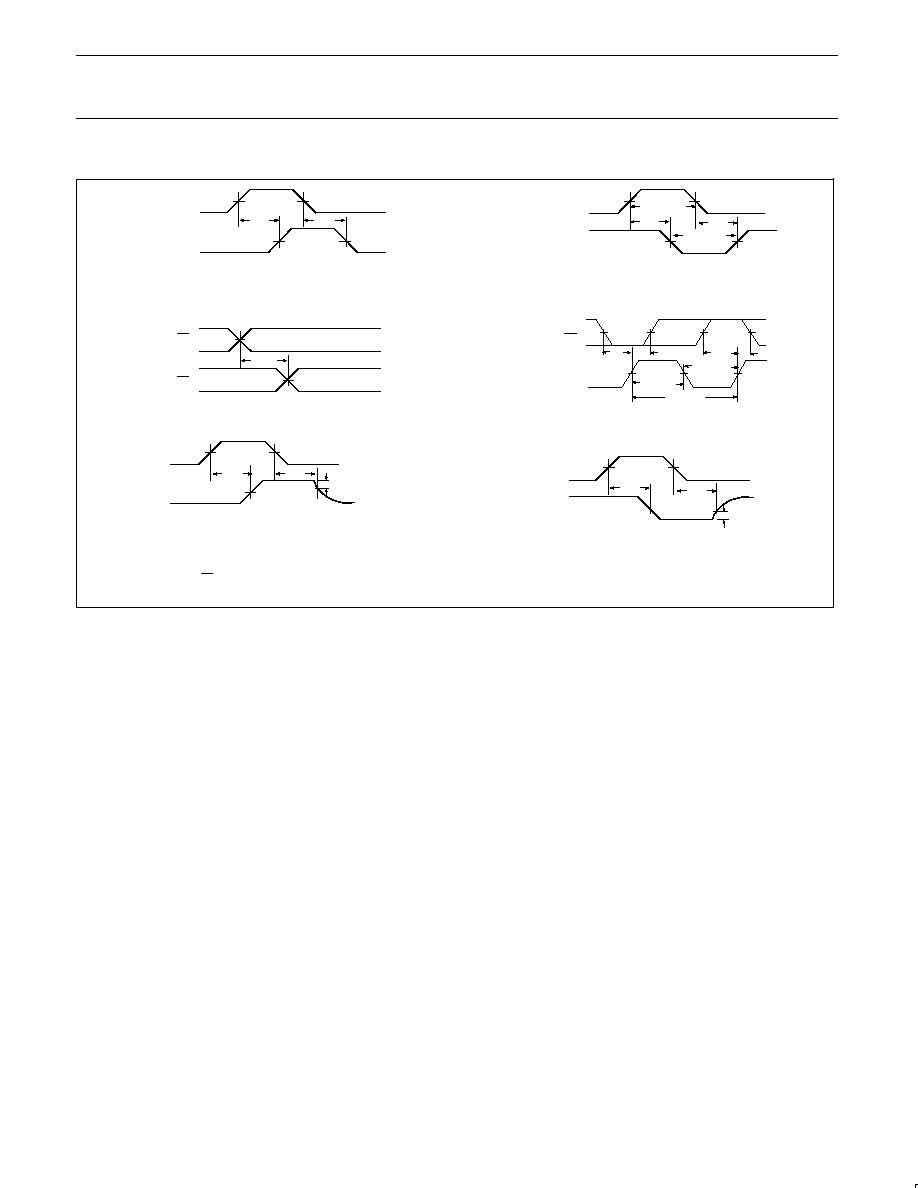
Philips Semiconductors
Product specification
FB2031
9-bit latched/registered/pass-thru Futurebus+ transceiver
1995 May 25
14
AC WAVEFORMS
ÍÍ
ÍÍ
VM
t
s
t
PZL
Input
Output
VM
VM
VM
VM
t
PLH
t
PHL
VM
VM
VM
VM
t
PHL
t
PLH
Output
An, Bn
An, Bn
VM
VM
tSK(o)
An
OEA
VM
VM
t
PLZ
VM
VOL +0.3V
An
OEA
VM
VM
VM
VOH -0.3V
OV
t
PHZ
t
PZH
NOTE: VM = 1.55V for Bn, VM = 1.5V for all others.
Input
ÍÍ
ÍÍ
ÍÍÍÍ
ÍÍÍÍ
An, Bn
LCAB, LCBA
VM
VM
1/fMAX
t
h
t
s
t
h
t
w(L)
t
w(H)
The shaded areas indicate when the input is permitted to change for predictable output performance.
Waveform 1. Propagation Delay for Data
or Output Enable to Output
Waveform 2. Propagation Delay for Data
or Output Enable to Output
Waveform 3. Output to Output Skew
Waveform 4. Setup and Hold Times,
Pulse Widths and Maximum Frequency
Waveform 5. 3-State Output Enable Time to High Level
and Output Disable Time from High Level
Waveform 6. 3-State Output Enable Time to Low Level
and Output Disable Time from Low Level
t
w
(input)
t
w
(output)
SG00062
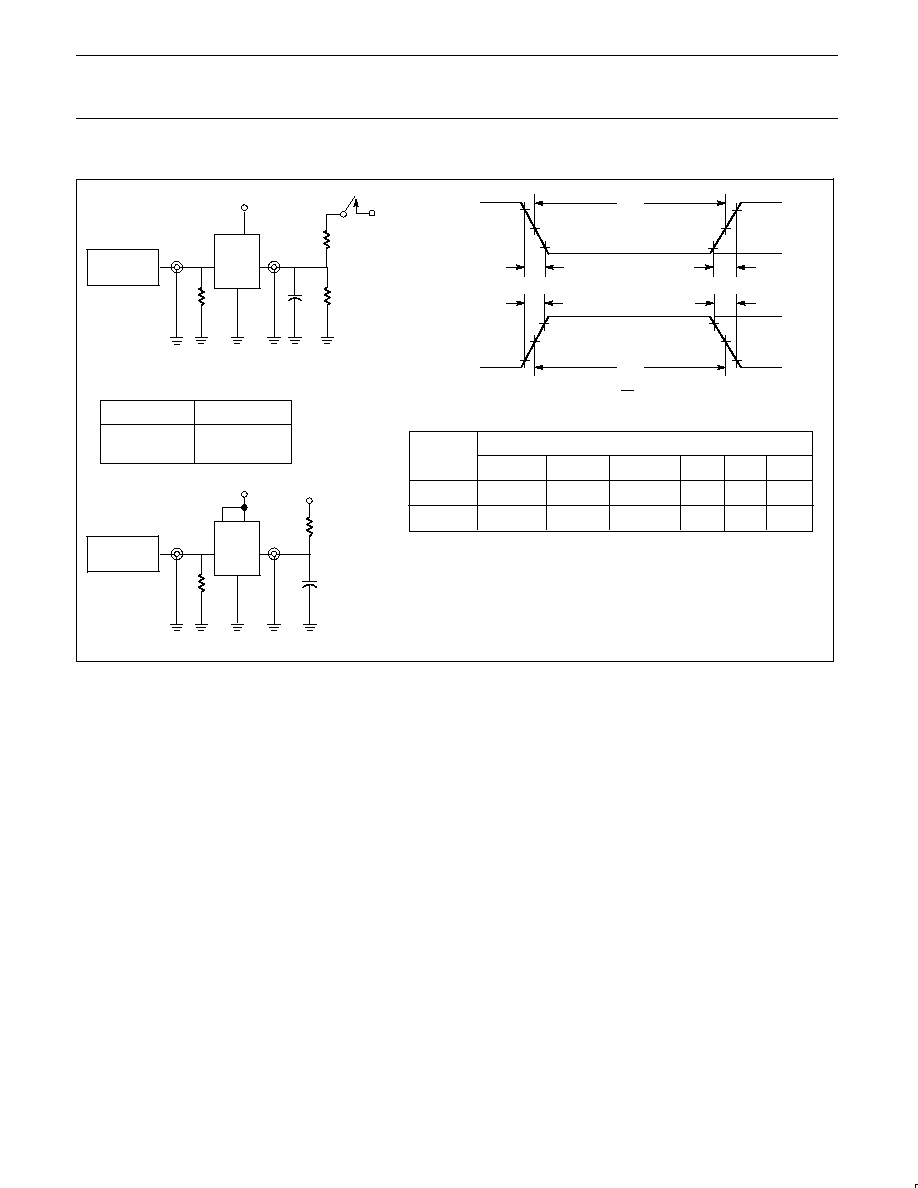
Philips Semiconductors
Product specification
FB2031
9-bit latched/registered/pass-thru Futurebus+ transceiver
1995 May 25
15
TEST CIRCUIT AND WAVEFORMS
2.5ns
2.0ns
500ns
500ns
INPUT PULSE REQUIREMENTS
Rep. Rate
Amplitude
t
TLH
t
THL
1MHz
3.0V
2.5ns
Input Pulse Definitions
VM = 1.55V for Bn, VM = 1.5V for all others.
VCC
Family
FB+
D.U.T.
PULSE
GENERATOR
7.0V
RL
RL
CL
RT
VIN
VOUT
Test Circuit for 3-State Outputs on A Port
TEST
SWITCH
SWITCH POSITION
t
PLZ,
t
PZL
All other
closed
open
DEFINITIONS:
R
L
= Load Resistor; see AC CHARACTERISTICS for value.
C
L
= Load capacitance includes jig and probe capacitance; see AC
CHARACTERISTICS for value.
R
T
= Termination resistance should be equal to Z
OUT
of pulse generators.
C
D
= Load capacitance includes jig and probe capacitance; see AC
CHARACTERISTICS for value.
R
U
= Pull up resistor; see AC CHARACTERISTICS for value.
tW
90%
VM
10%
90%
VM
10%
90%
VM
10%
90%
VM
10%
NEGATIVE
PULSE
POSITIVE
PULSE
AMP (V)
LOW V
LOW V
tTHL
(t
f
)
tTLH
(t
r
)
tW
t
W
Low V
0.0V
tTLH
(t
r
)
tTHL
(t
f
)
AMP (V)
A Port
1MHz
2.0V
2.0ns
1.0V
B Port
V
CC
D.U.T.
PULSE
GENERATOR
R
U
C
D
R
T
V
IN
V
OUT
Test Circuit for Outputs on B Port
BIAS
V
2.0V (for R
U
= 9
)
2.1V (for R
U
= 16.5
)
SG00063
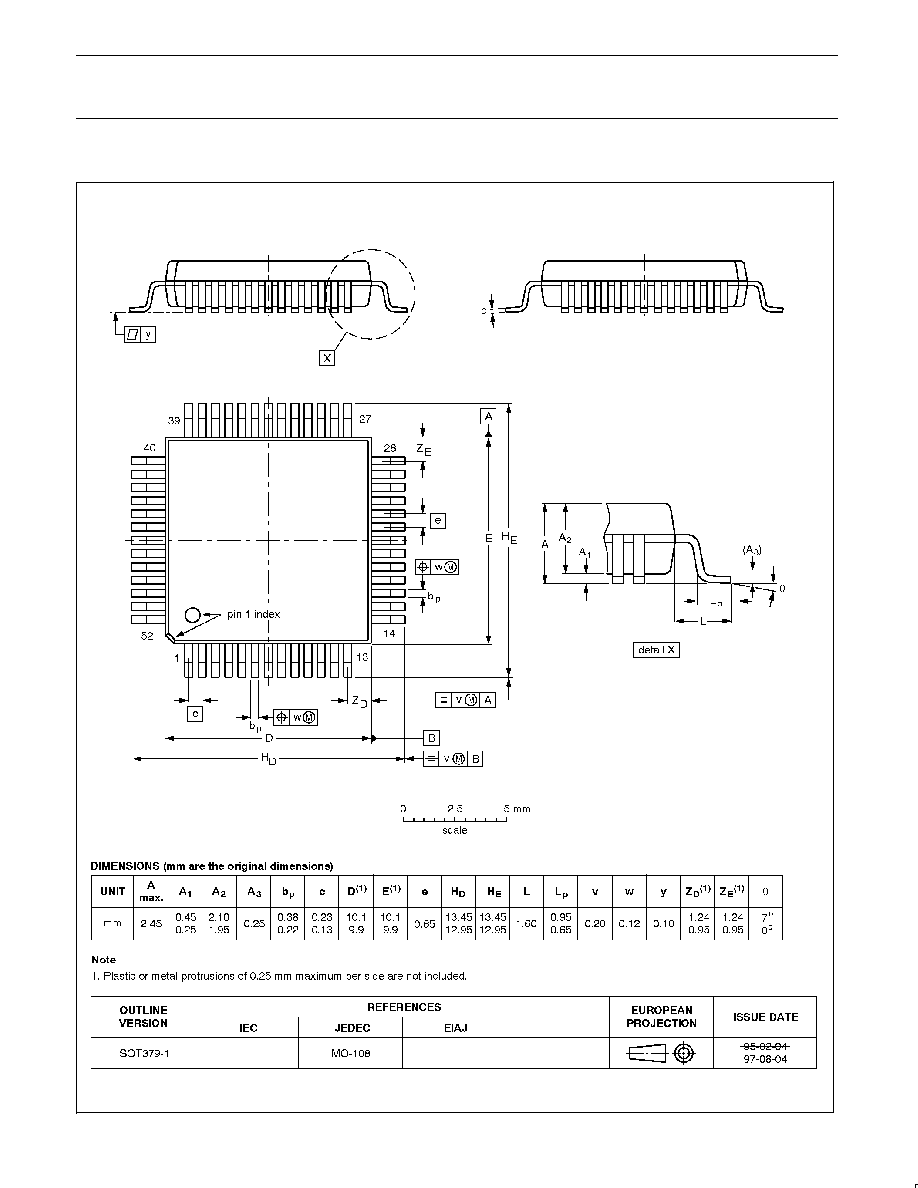
Philips Semiconductors
Product specification
FB2031
9-bit latched/registered/pass-thru Futurebus+ transceiver
1995 May 25
16
QFP52:
plastic quad flat package; 52 leads (lead length 1.6 mm); body 10 x 10 x 2.0 mm
SOT379-1

Philips Semiconductors
Product specification
FB2031
9-bit latched/registered/pass-thru Futurebus+ transceiver
1995 May 25
17
NOTES

Philips Semiconductors
Product specification
FB2031
9-bit latched/registered/pass-thru Futurebus+ transceiver
1995 May 25
18
Definitions
Short-form specification -- The data in a short-form specification is extracted from a full data sheet with the same type number and title. For
detailed information see the relevant data sheet or data handbook.
Limiting values definition -- Limiting values given are in accordance with the Absolute Maximum Rating System (IEC 134). Stress above one
or more of the limiting values may cause permanent damage to the device. These are stress ratings only and operation of the device at these or
at any other conditions above those given in the Characteristics sections of the specification is not implied. Exposure to limiting values for extended
periods may affect device reliability.
Application information -- Applications that are described herein for any of these products are for illustrative purposes only. Philips
Semiconductors make no representation or warranty that such applications will be suitable for the specified use without further testing or
modification.
Disclaimers
Life support -- These products are not designed for use in life support appliances, devices or systems where malfunction of these products can
reasonably be expected to result in personal injury. Philips Semiconductors customers using or selling these products for use in such applications
do so at their own risk and agree to fully indemnify Philips Semiconductors for any damages resulting from such application.
Right to make changes -- Philips Semiconductors reserves the right to make changes, without notice, in the products, including circuits, standard
cells, and/or software, described or contained herein in order to improve design and/or performance. Philips Semiconductors assumes no
responsibility or liability for the use of any of these products, conveys no license or title under any patent, copyright, or mask work right to these
products, and makes no representations or warranties that these products are free from patent, copyright, or mask work right infringement, unless
otherwise specified.
Philips Semiconductors
811 East Arques Avenue
P.O. Box 3409
Sunnyvale, California 940883409
Telephone 800-234-7381
©
Copyright Philips Electronics North America Corporation 2000
All rights reserved. Printed in U.S.A.
print code
Date of release: 01-0006835
Document order number:
9397 750
Philips
Semiconductors
Data sheet
status
Objective
specification
Preliminary
specification
Product
specification
Product
status
Development
Qualification
Production
Definition
[1]
This data sheet contains the design target or goal specifications for product development.
Specification may change in any manner without notice.
This data sheet contains preliminary data, and supplementary data will be published at a later date.
Philips Semiconductors reserves the right to make chages at any time without notice in order to
improve design and supply the best possible product.
This data sheet contains final specifications. Philips Semiconductors reserves the right to make
changes at any time without notice in order to improve design and supply the best possible product.
Data sheet status
[1]
Please consult the most recently issued datasheet before initiating or completing a design.

















